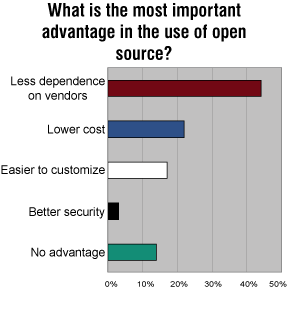Computer Economics recently conducted a survey of visitors to its website regarding the perceived advantages in the use of open source software. Although not a scientific sample, the results are nevertheless startling.
As nearly everyone knows, open source software is a low cost alternative to proprietary software. For example, the open source Linux operating system is commonly seen as a low cost alternative to Microsoft’s Server 2003 operating system, or Sun’s version of Unix. The popularity of open source is seen in the fact that today the largest market share for web servers is held by the open source Apache system.
One might think, therefore, that the key advantage of open source software is its low cost of ownership. But visitors to our website didn’t think so.
Open Source Does Have Advantages
Our survey offered respondents a choice of five advantages for open source.
- Lower total cost of ownership
- Reduced dependence on software vendors
- Easier to customize
- Higher level of security
- Do not see a significant advantage
The results of the survey are shown in the chart below.
|
|
Before we discuss at the topmost advantage of open source, let’s look at what respondents are not saying.
Even though advocates of open source products such as Linux tout its security, only 3% of repondants ranked “higher level of security” as the key advantage of open source in general. In addition, although open source software is by definition open to user modification, only 17% of respondents ranked “easier to customize” as the key advantage.
Furthermore, only 14% of respondents thought that open source had no significant advantages over proprietary software.
Free is not free
So, what is the top advantage of open source? The leading vote-getter was “reduced dependence on software vendors” at 44%, followed by “lower total cost of ownership” at 22%. Although these were the top two vote-getters, it is enlightening that respondents valued reduced dependence on software vendors by a two-to-one margin over lower cost.
The second place ranking for “lower cost” indicates that IT decision makers recognize that open source software is not really free. With most types of software, administration and support costs overshadow initial software license cost and annual maintenance fees–the costs that are minimized by open source. Therefore, software buyers do not see the low or zero initial cost of open source as its most important advantage.
Whether open source software is less costly to administer than proprietary software depends largely on a ready pool of resources trained on the system, the availability of administration tools that allow system administrators to manage a greater number of systems, and the number of version upgrades and patches that are issued by the developer. In this regard, open source software may have little if any advantage over proprietary software, although the situation varies from application to application. Therefore, low cost, although important, is not the key advantage of open source.
Valuing independence
The survey indicates that IT decision makers value “reduced dependence on software vendors” as the most important advantage of open source. This indicates that software buyers must feel some level of dependence on proprietary software vendors, from which they desire freedom. Such dependence includes reliance on the vendor for maintenance and support and the necessity for the buyer to accept version upgrades that the buyer may not need or want.
For example, when Microsoft announces a new version of its Windows Server operating system, it invariably phases out support for older versions of the system. Users that are satisfied with older versions of Windows will be eventually forced to upgrade if they want to continue receiving vendor support. In contrast, there is no forced upgrade cycle with open source. Older versions of open source products continue to be supported through the open source community and third party support providers as long as there is demand in the marketplace for such support.
Our survey indicates that vendors of proprietary software are missing the mark when they argue that open source software has a higher total cost of ownership, is less secure, or higher risk in terms of ongoing support. These factors, although important, are not the key concern of software buyers. The key appeal of open source software is that it avoids vendor lock-in and gives buyers the freedom to choose what to do and when to do it.
How can proprietary software vendors address this concern of buyers? Simply fighting open source on the basis of price cuts, or by spreading fear, uncertainty, and doubt about open source will not work. For software vendors, the best path is to adhere to open standards and develop web services that promote interoperability of their products with those of other vendors and with open source products as well. Ironically, the best way for software vendors to preserve and gain market share today is by giving buyers the freedom to abandon the vendor’s own product. Don’t lock-in buyers and buyers won’t be as likely to leave.
For software buyers, the best strategy is to consider mature and established open source products as well as proprietary software products that adhere to open standards. In this way, buyers can choose the best software product for the job, knowing that the value of their investment will be preserved without locking the organization in to a single vendor solution.
Update: On May 12, 2005 this Research Byte was linked by Slashdot, and Computer Economics was deluged by over 50,000 hits in one day. Based on insights gained from feedback on Slashdot, we have written a more in-depth research report on this subject.
Please also refer to our later report, Open Source Business Apps Show Strong ROI.
Survey designed by Computer Economics President, Frank Scavo.




